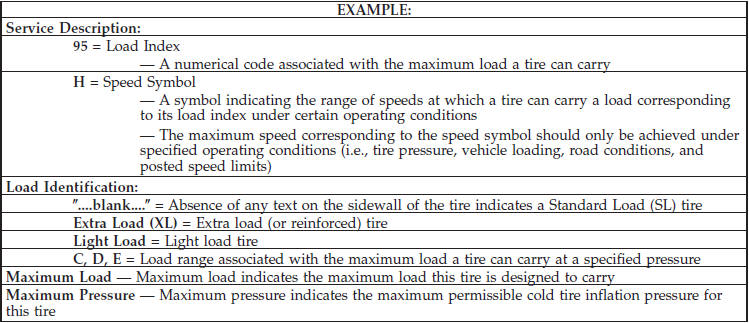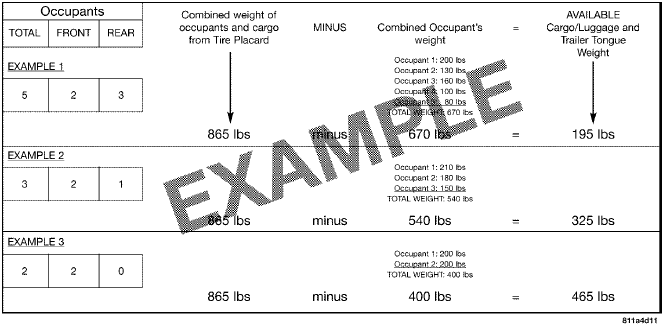 Dodge Nitro: Tire safety information
Dodge Nitro: Tire safety information
Tire Markings

1 тАФ U.S. DOT Safety Standards Code (TIN). 4 тАФ Maximum Load. 2 тАФ Size Designation. 5 тАФ Maximum Pressure. 3 тАФ Service Description. 6 тАФ Treadwear, Traction and Temperature Grades.
NOTE:
тАв P (Passenger) - Metric tire sizing is based on U.S.
design standards. P-Metric tires have the letter тАЬPтАЭ
molded into the sidewall preceding the size designation.
Example: P215/65R15 95H.
тАв European-Metric tire sizing is based on European
design standards. Tires designed to this standard have
the tire size molded into the sidewall beginning with
the section width. The letter P is absent from this tire
size designation. Example: 215/65R15 96H.
тАв LT (Light Truck) - Metric tire sizing is based on U.S.
design standards. The size designation for LT-Metric
tires is the same as for P-Metric tires except for the
letters тАЬLTтАЭ that are molded into the sidewall preceding
the size designation. Example: LT235/85R16.
тАв Temporary spare tires are high-pressure compact
spares designed for temporary emergency use only.
Tires designed to this standard have the letter тАЬTтАЭ
molded into the sidewall preceding the size designation.
Example: T145/80D18 103M.
тАв High flotation tire sizing is based on U.S. design
standards and it begins with the tire diameter molded
into the sidewall. Example: 31x10.5 R15 LT.
Tire Sizing Chart


Tire Identification Number (TIN)
The TIN may be found on one or both sides of the tire, however, the date code may only be on one side. Tires with white sidewalls will have the full TIN, including the date code, located on the white sidewall side of the tire. Look for the TIN on the outboard side of black sidewall tires as mounted on the vehicle. If the TIN is not found on the outboard side, then you will find it on the inboard side of the tire.

Tire Terminology and Definitions

Tire Loading and Tire Pressure
Tire Placard Location
NOTE: The proper cold tire inflation pressure is listed on the driverтАЩs side B-Pillar.
 Tire Placard Location
Tire Placard Location
Tire and Loading Information Placard
 Tire and Loading Information Placard
Tire and Loading Information Placard
This placard tells you important information about the: 1) number of people that can be carried in the vehicle. 2) total weight your vehicle can carry. 3) tire size designed for your vehicle. 4) cold tire inflation pressures for the front, rear, and spare tires.
Loading
The vehicle maximum load on the tire must not exceed the load carrying capacity of the tire on your vehicle. You will not exceed the tireтАЩs load carrying capacity if you adhere to the loading conditions, tire size, and cold tire inflation pressures specified on the Tire and Loading Information placard and in the тАЬVehicle LoadingтАЭ section of this manual.
NOTE: Under a maximum loaded vehicle condition, gross axle weight ratings (GAWRs) for the front and rear axles must not be exceeded. For further information on GAWRs, vehicle loading, and trailer towing, refer to тАЬVehicle LoadingтАЭ in this section. To determine the maximum loading conditions of your vehicle, locate the statement тАЬThe combined weight of occupants and cargo should never exceed XXX lbs or XXX kgтАЭ on the Tire and Loading Information placard. The combined weight of occupants, cargo/luggage and trailer tongue weight (if applicable) should never exceed the weight referenced here.
Steps for Determining Correct Load Limit
1. Locate the statement тАЬThe combined weight of occupants and cargo should never exceed XXX lbs or XXX kgтАЭ on your vehicleтАЩs placard. 2. Determine the combined weight of the driver and passengers that will be riding in your vehicle. 3. Subtract the combined weight of the driver and passengers from XXX lbs or XXX kg.
4. The resulting figure equals the available amount of cargo and luggage load capacity. For example, if тАЬXXXтАЭ amount equals 1,400 lbs (635 kg) and there will be five 150 lb (68 kg) passengers in your vehicle, the amount of available cargo and luggage load capacity is 650 lbs (295 kg) (since 5 x 150 = 750, and 1400 тАУ 750 = 650 lbs [295 kg]). 5. Determine the combined weight of luggage and cargo being loaded on the vehicle. That weight may not safely exceed the available cargo and luggage load capacity calculated in Step 4. 6. If your vehicle will be towing a trailer, load from your trailer will be transferred to your vehicle. Consult this manual to determine how this reduces the available cargo and luggage load capacity of your vehicle.
NOTE:
тАв The following table shows examples on how to calculate
total load, cargo/luggage, and towing capacities
of your vehicle with varying seating configurations
and number and size of occupants. This table is for
illustration purposes only and may not be accurate for
the seating and load carry capacity of your vehicle.
тАв For the following example, the combined weight of
occupants and cargo should never exceed 865 lbs
(392 kg).

WARNING: Overloading of your tires is dangerous. Overloading can cause tire failure, affect vehicle handling, and increase your stopping distance. Use tires of the recommended load capacity for your vehicle. Never overload them.
 Electronic brake control system
Electronic brake control system
Your vehicle is equipped with an advanced electronic
brake control system that includes an Anti-Lock Brake
System (ABS), Traction Control System (TCS), Brake Assist
System (BAS), Electronic Roll ...
 Tires тАФ general information
Tires тАФ general information
Tire Pressure
Safety
WARNING:
тАв Improperly inflated tires are dangerous and can
cause accidents.
тАв Under-inflation increases tire flexing and can result
in over-heating and tire failure. ...
See also:
Important safety notes
WARNING
Grains of sand, particles of dirt and other abrasive materials can enter the
brake system. This can lead to excessive wear and unpredictable braking efficiency.
After the brakes have ...
Sunroof
On vehicles with a sunroof, the switches used to operate it are on the headliner
above the rearview mirror. The ignition must be in ON/ RUN or ACC/ACCESSORY, or
in Retained Accessory Power (RAP) t ...
If the Engine Overheats
The reading of the vehicleтАЩs
temperature gauge should stay in
the midrange. If it climbs to the red
mark, you should determine the
reason (hot day, driving up a steep
hill, etc.).
If the ...
